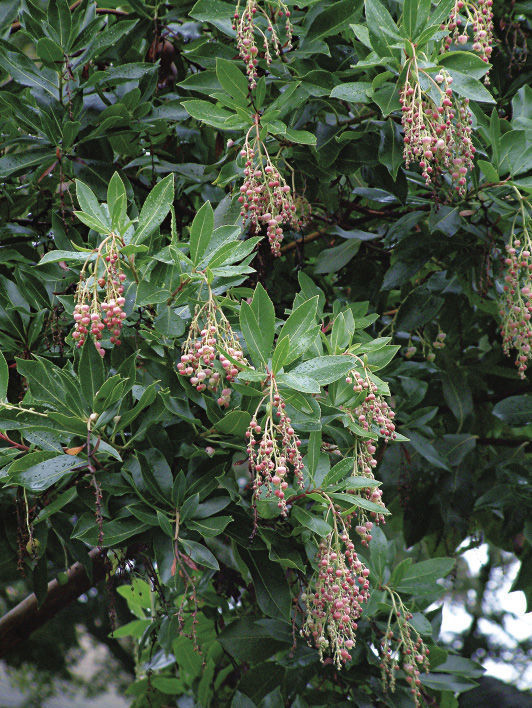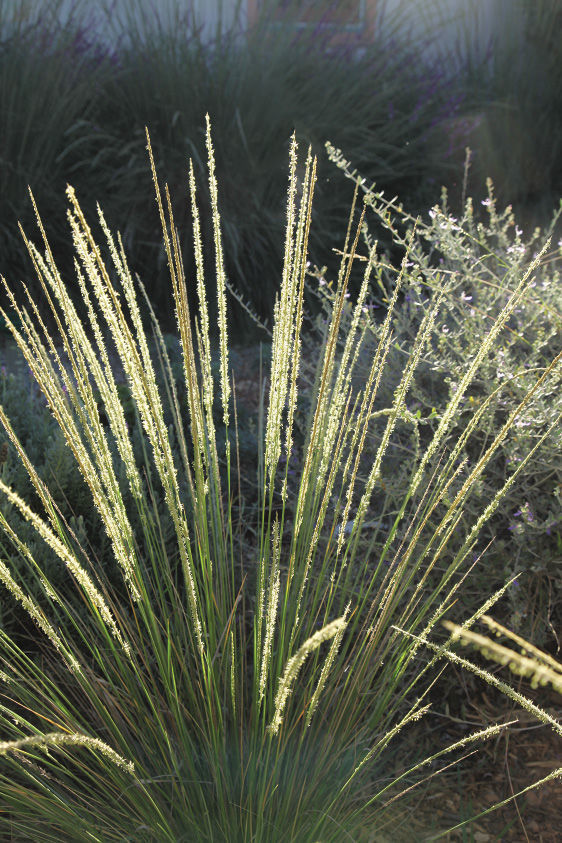
If you’re sick of the same old asters and mums, why not plant an unexpected fall-star instead?
Here some truly out-of-the-ordinary plants for upping your fall garden game in Northern California. Some of these options provide excellent foliage color while others put on a floral display in the final throws of October.
Looking for some autumnal stars for your containers instead? Read Autumn Pots Minus the Mums by Sarah Partyka for even more out-of-the-box fall planting inspiration.
1. ‘Marina’ Strawberry Tree

Name: Arbutus ‘Marina’
USDA Hardiness Zones: 8 to 10
Size: 20 to 40 feet tall and 20 to 30 feet wide
Conditions: Full sun; needs good drainage and prefers infrequent irrigation
‘Marina’ strawberry tree has everything: ornamental bark; flowers; fruit; and dark, leathery, evergreen leaves. Reported to grow up to 50 feet tall along the California coast, it is slow growing and unlikely to reach that size in a hotter, interior California garden. The branches have a muscular form, with smooth mahogany bark that peels in autumn to reveal a lighter cinnamon color beneath. In our area, this tree produces beautiful pendulous clusters of rosy pink flowers in January, followed by attractive red fruit. Grown as a multitrunked specimen, the sculptural branches make a marvelous focal point in the low-water garden.
2. Giant Sea Squill

Name: Drimia maritima (syn. Urginea maritima)
Zones: 8 to 10
Size: Winter foliage, 1 to 2 feet tall and wide; flower stalk, up to 5 feet tall
Conditions: Full sun; tolerates a range of soil types, with or without summer irrigation
Giant sea squill is a football-size bulb native to the Mediterranean region and well adapted to our dry, rainless summers. In winter, the bulbs sprout leaves that are 2 feet long and 6 inches wide coated with a waxy bluish bloom. The leaves drop off with the onset of summer heat, then, in August and September, the bulb sends up an amazing 3- to 5-foot-tall tower of starry white flowers. Site this easy-to-grow plant the same way that you would California’s ubiquitous belladonna lily (Amaryllis belladonna, Zones 9–10). It works well combined with drought-tolerant, winter-deciduous herbaceous perennials, such as California fuchsia (Epilobium canum, Zones 8–10).
3. Pine Muhly

Name: Muhlenbergia dubia
Zones: 6 to 9
Size: 3 feet tall and wide
Conditions: Full sun; not fussy about soil and prefers infrequent irrigation
Pine muhly is a dense evergreen native grass. It produces a durable, year-round display of tan flower spikes reminiscent of a Fourth of July fireworks explosion. Similar to native California deer grass (Muhlenbergia rigens, Zones 6–10), pine muhly is neater and more petite, growing to only half the size. Valued for its tough nature and symmetrical form, it tolerates difficult conditions, such as road medians and south-facing walls. In the dry garden, its soft texture contrasts nicely with darker-foliage plants and large succulents, especially when backlit by the afternoon sun. Cut this plant hard to the ground every few years to rejuvenate it.
4. Shrubby Hare’s Ear

Name: Bupleurum fruticosum
Zones: 6 to 9
Size: 4 to 6 feet tall and wide
Conditions: Full sun to light shade; tolerates alkaline soil and prefers infrequent irrigation
Shrubby hare’s ear is an understated evergreen shrub with smooth, leathery, gray-green leaves. It produces fascinating yellow-green umbels from July through September. Easily shaped, it can be used as a screen, hedge, or specimen. For best form, prune to induce branching when the plant is young. The flower clusters are produced on the stem ends; they make long-lasting cut flowers, which are especially charming when mixed with dark maroon foliage. This plant is adaptable to sun or shade, and it requires little water once established.
Ellen Zagory is director of public horticulture at the University of California–Davis Arboretum.
Photos: #1, Joshua McCullough; #2, Donkey shot/courtesy of commons.wikimedia.org; #3, courtesy of San Marcos Growers; #4, Doreen Wynja


















Comments
Log in or create an account to post a comment.
Sign up Log in